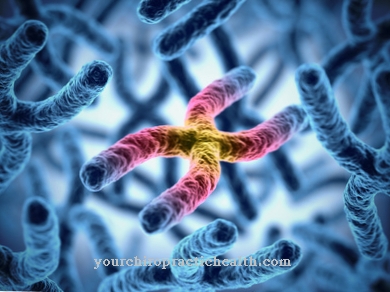A Shunt is a connection between cavities or vessels that are actually separated from each other. This connection can take place naturally, for example through a malformation, or it can also be created artificially, for example to support medical treatment.
What is a shunt?

Under a Shunt Doctors understand a so-called short circuit, i.e. H. a connection between vessels or hollow organs that are otherwise naturally separated from each other.
In this way, for example, veins and arteries can be connected to each other in order to increase the blood flow and thus to achieve services that are not possible through natural blood vessels alone. Some shunts occur naturally (for example in the embryonic stage or due to malformations); but mostly they are placed artificially.
In the latter case, they are part of a medical treatment in which it is necessary to achieve an effective flow of body fluids. The best known are shunts that are placed on the forearm of dialysis patients.
Shapes, types & types
Shunts are basically divided in medicine into naturally occurring and artificially created shunts. Natural shunts occur, for example, through a malformation (malformation).
In the embryonic stage, fetuses also have three shunts that close by themselves after birth. These are the liver shunt, the atrial shunt and the aortic shunt. They are used to absorb oxygen by the fetus, which cannot yet absorb it by breathing. If these shunts do not close completely, heart defects can develop.
Artificially created shunts are necessary when a constant flow of body fluids such as blood between two cavities / vessels has to be guaranteed. They are surgically inserted into the affected body region and can serve different specific purposes.
Structure, use & functionality
With an artificial one Shunt it is a tube that is implanted in the body. This requires a surgical procedure, which can be more or less complicated depending on the position.
Very often such artificial shunts connect veins and arteries and thus enable a constant blood flow. This is necessary, for example, when dialysis is to be carried out regularly. Such a shunt must have a certain, as large as possible diameter and also be particularly long in order to enable puncture with two needles. It is used as close as possible under the skin so that the punctures can be made without any problems.
When placing a shunt, it is essential to pay attention to hygiene, as it is located inside the body (for example under the skin) and germs could cause serious damage to health. If, for example, a shunt is placed in the forearm because regular dialysis is required, it usually takes some time for the patient to get used to the foreign body.
As long as the shunt is in the body and in use, it must be monitored repeatedly to determine whether it is performing its function optimally.
Medical & health benefits
The natural ones Shuntsthat are present in the body of a fetus have the primary function of supplying oxygen to the embryo. Since the lungs have collapsed at this point and there is no regular breathing, the shunts provide the growing organism with the oxygen it needs.
As already mentioned, artificial shunts are usually used when the patient has kidney failure and dialysis must therefore take place regularly. In these cases, the shunt is vital, as the necessary blood flow can only take place through it. In most cases it is placed in the forearm; if this is not possible, it can also be on the neck. However, this usually means that the patient's mobility is restricted and is usually perceived as more uncomfortable.
So-called cerebral shunts have the no less important task of redirecting excess cerebrospinal fluid through a tube into the abdomen and thus reducing intracranial pressure. With some congenital heart defects, a shunt can also be placed to connect the arterial and venous circulation and thus significantly improve the oxygen supply.


.jpg)





















.jpg)



